Winter Injury in Northern Illinois Grapes
Grapes that grow well in Illinois. To find out more use the link below.
Concord – Catawba – Niagara – Marechal Foch
Tips and Resources
Pruning – Grape Diseases and Management
Concord

The Concord grape is a cultivar derived from the grape species Vitis labrusca that are used as table grapes, wine grapes and juice grapes. They are often used to make grape jelly, grape juice, grape pies, grape-flavored soft drinks, and candy.
Concord grapes, botanically classified as Vitis labrusca, grow on hardy vines and are members of the Vitaceae family. Named after their city of origin, Concord, Massachusetts, Concord grapes have been a part of American viticulture since 1843 and have wild, native, New England ancestors. Concord grapes are one of the oldest domestically cultivated grapes grown today and are responsible for making the famous grape juice and jelly.
Concord grapes are an excellent source of vitamin C and the phytonutrient, resveratrol, an important chemical in maintaining heart health.
Catawba
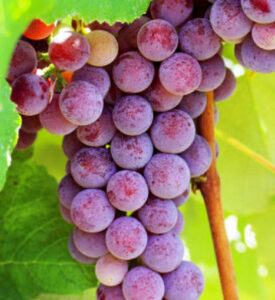
Catawba are vigorous, hardy, deciduous vine with bold-textured, deep green foliage. Grown for its medium-size clusters of round, dull purple-red grapes. Catawba grapes are well-suited for jellies and juices, and for sweet white, red and rosé wines. Fruit ripens late in the season.
Catawba is self-fertile, but planting more than one vine is recommended for the best crop. Catawba should be planted 6’–8′ apart using a trellis system.
The Catawba grape prefers a deep, acidic (pH 5.0-6.5), well-drained, sandy soil but can tolerate a wide range of soil types (except alkaline and wet).
Niagara
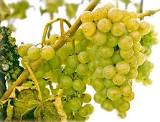
Some call it “White Concord” because it has the same vigor, productivity and extreme hardiness. Bears big clusters of huge, slip-skin, seeded grapes. Absolutely terrific for fresh eating, jelly or making your own wine. Ripens mid to late September.
Niagara grapes are medium to large in size and are globose in shape, growing in large clusters. The smooth, glossy skin is firm and can range in color from light green to a pale, yellow-green. The skin also develops a thin bloom or film that helps protect the grape from moisture loss. The translucent, green flesh is juicy and seedless. Niagara grapes are crisp and sweet with a very grapey or foxy flavor, which can best be described as slightly musty or tannic.
Niagara grapes are available late summer through early fall. In many cases, you may still want to plant pollinating partners to increase the size of your crops, but with self-pollinating varieties doing so is optional. You’ll get fruit with only one plant!
Marechal Foch
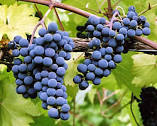
Foch is early-ripening and one of the hardiest French hybrids. Widely grown commercially. Birds prefer small, black, early grapes, so Marechal Foch is particularly attractive to them. As its clusters are relatively small, it should not be pruned severely.
Quite resistant to common grape diseases; slight susceptibility to both powdery and downy mildew
Tips and Resources
Pruning
This link from Washington State University give you some basic guidelines on how to prune grape vines.
Grape Diseases and Management
University of Missouri Grape Diseases and Management
University of Wisconsin-Madison: A Photographic Diagnostic Guide For Identification Of Cold-Climate Wine Grape Pathogens
Winter Injury in Northern Illinois Grapes
by Bill Shoemaker
Reprinted with permission: Illinois Fruit and Vegetable News Vol. 15, No. 3, April 17, 2009
http://ipm.illinois.edu/ifvn/volume15/frveg1503.html
(A Publication of University of Illinois Extension and the College of Agricultural, Consumer, and Environmental Sciences)
From The Grapevine, Summer (June) 2009.
The winter of 2008-2009 will probably be remembered in northern Illinois as a persistently cold one that helped us sort out which grape varieties should be planted here. On January 16 and the following couple of nights, temperatures bottomed out at levels that were colder than the previous 5-10 winters. In northeastern Illinois, most rural sites were below minus 20°F, and some were colder than -30°F. Actual temperatures in vineyards may have differed from nearby weather stations in the rolling hills of northwestern Illinois, as cold air settled in low areas.
Fortunately, the vines were conditioned to be in full dormancy by the gradual development of cold temperatures. Dormant plants will respond to slowly lowering temperatures by descending into full dormancy. Each variety has its limitations though. It is not unusual for tender hybrids to be hardier than European grapes but to be injured by temperatures in the -15 to -20°F range. The popular cultivars Chambourcin and Chardonel are examples of such hybrids. Hardier hybrids may be able to withstand much colder temperatures. The varieties coming from Minnesota’s breeding program or the private breeder Elmer Swenson of Eau Claire, WI may be able to withstand temperatures that drop to -35 to -40°F. Even some French hybrids, such as Marechal Foch, can take temperatures colder than -30°F if conditioned properly). Unfortunately, many vineyards in northern Illinois may not have been conditioned properly last winter.
This isn’t necessarily due to poor management. Last season was a very challenging season. We were generally low on heat units across northern Illinois because of prevailing cloudy, wet conditions. The frequent rainfall led to high disease pressure. Also, an unusually challenging infestation of Japanese beetles led to vegetative canopies being ravaged. All of this led to low levels of photosynthesis and reduced energy available to the vine for storage into winter. This could have been exacerbated in some vineyards by excessive crop loads, and by the fact that the previous growing season had similar conditions. Being aware of the relative strength of vines and their limitations will be a key to growing grapes in the northern part of Illinois. Brad Taylor of Southern Illinois University and I are collecting dormant cane material from different vineyards in Illinois to determine the bud survival rates in those varieties. More information on this will come later.
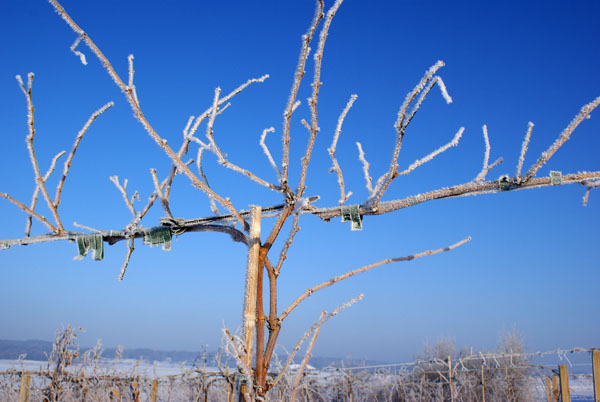
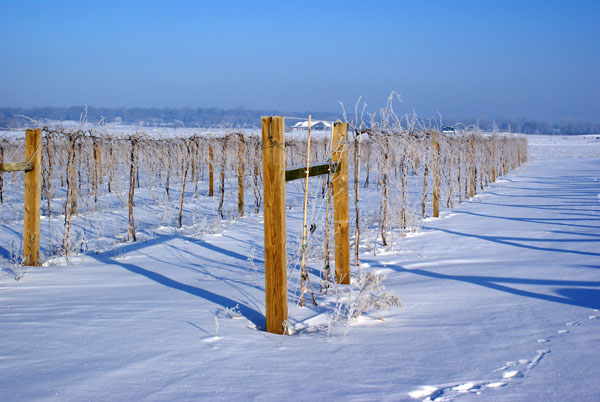
Growers were busily pruning vineyards in late March and early April, and many have now finished, and the process of pruning should reveal winter damage. Many canes hanging from cordons may have a gray, desiccated appearance. They may feel soft and light, and when cutting through while pruning, they will show no green color in the cambium layer just below the thin bark. These are canes that have died back. Some die-back is normal at the tips of canes where wood is thin. Where the wood is pencil-sized in thickness it should survive if the variety’s minimum cold tolerance is not exceeded. If canes of good thickness are not showing good green color in the cambium layer, the vine has suffered die-back, either due to excessive cold or lack of energy, or both.
This season may have been a watershed for determining variety suitability in Illinois, particularly in the north. Growers should record the extent of damage they experienced in each variety they grow and assess the reason for the damage. If management led to vines that were in less than optimal condition, then corrective measures should be taken. Vine health is critical to the long-term investment in a vineyard. If management was optimal or at least suitable, and vines had sufficient energy going into the fall, growers should consider the possibility that the variety is not appropriate for their site. There is no area of Illinois where suitable wine grape varieties cannot be grown. However, every area of Illinois can serve as a site for making poor variety choices. Mother Nature will be the judge.
Growers with damaged vines will need to make decisions about the future for those varieties. If the varieties are suitable, the growers will need to rehabilitate vines. Next issue will have some discussion on bringing vines back into optimal health.